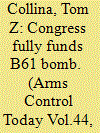|
|
|
Sort Order |
|
|
|
Items / Page
|
|
|
|
|
|
|
| Srl | Item |
| 1 |
ID:
129134


|
|
|
|
|
| Publication |
2014.
|
| Summary/Abstract |
Striking a compromise on a controversial issue, Congress in January passed legislation to provide $537 million, the full amount the Obama administration had requested, for the program to rebuild the B61 nuclear gravity bomb and require the administration to submit detailed reports on alternatives to this plan. Congress also mandated the eventual retirement of a different gravity bomb, the B83, once the B61 is ready for service. These items were part of an omnibus appropriations bill signed by President Barack Obama on Jan. 17. The new law is a $1.1 trillion conglomeration of 12 appropriations bills that had to be passed to keep the government open for the remainder of the fiscal year, which ends Sept. 30. The legislation includes $7.8 billion for nuclear weapons activities conducted by the Energy Department's semiautonomous National Nuclear Security Administration (NNSA). One of the key nuclear policy questions left unresolved last year was how much money the NNSA would be allowed to spend to extend the service life of about 400 B61 gravity bombs. About half of the B61s are stored in European NATO countries for use on tactical, or short-range, aircraft; the rest are stored in the United States for use on strategic, or long-range, bombers.
|
|
|
|
|
|
|
|
|
|
|
|
|
|
|
|
| 2 |
ID:
130349


|
|
|
|
|
| Publication |
2014.
|
| Summary/Abstract |
The Energy Department announced last month that it has decided to mothball the facility that has been the centerpiece of its effort to get rid of plutonium from the U.S. nuclear weapons program as the department reviews other options for that task. In public comments by department officials and in budget documents for fiscal year 2015, the department said it was putting the facility into "cold standby," meaning that work on the structure will be scaled back to activities such as protecting the facility and its equipment from the elements and keeping the site secure. Those activities would preserve the facility for some potential future use. The facility is under construction by an Energy Department contractor at the department's Savannah River Site in South Carolina. It is designed to turn the plutonium into mixed-oxide (MOX) fuel-so called because it is a mix of plutonium and uranium oxides-for use in nuclear power reactors.
Under an agreement that Russia and the United States signed in 2000, each country is required to dispose of at least 34 metric tons of surplus weapons plutonium. In the United States, that mission is the responsibility of the National Nuclear Security Administration (NNSA), a semiautonomous unit of the Energy Department. The NNSA budget request for fiscal year 2015 would provide $196 million for construction of the MOX fuel fabrication plant and another $25 million for other associated costs, down from $344 million and $40 million appropriated for the current fiscal year. Spending for Fissile Materials Disposition, the section of the NNSA budget that includes those expenditures, would drop from $526 million to $311 million. During a March 4 conference call with reporters, Anne Harrington, NNSA deputy administrator for defense nuclear nonproliferation, said the ongoing analysis of plutonium disposition options had not eliminated the current approach as an option. But keeping that approach would require the facility's total life-cycle costs to decrease considerably, she said. Those costs are now estimated to be about $30 billion, according to the Energy Department.
|
|
|
|
|
|
|
|
|
|
|
|
|
|
|
|
| 3 |
ID:
130345


|
|
|
|
|
| Publication |
2014.
|
| Summary/Abstract |
Despite pressure to reduce military budgets, the Obama administration is planning to increase spending significantly to modernize nuclear-armed missiles, submarines, and bombers and to maintain nuclear warheads in the decades ahead, according to budget documents released in March Defense Secretary Chuck Hagel testified before the House Armed Services Committee on March 6 that "tough, tough choices are coming" if the Pentagon is forced to make deep spending cuts as required by law. The services are considering cutting 20,000 to 30,000 soldiers and retiring an aircraft carrier, among other money-saving steps.
But the Pentagon is not proposing to scale back its highest-priority nuclear modernization programs. The Pentagon's proposed $496 billion budget for fiscal year 2015, released March 4, would "preserve all three legs of the nuclear triad," Hagel said, and includes hefty down payments for new delivery systems. The nuclear warhead programs, overseen by the National Nuclear Security Administration (NNSA), a semi-autonomous unit of the Energy Department, also would get a budget increase. The administration would pay for these increases in part by cuts to some lower-priority programs.
|
|
|
|
|
|
|
|
|
|
|
|
|
|
|
|
|
|
|
|
|